人教版新目标初中英语七年级下册It’s raining说课稿5篇下载
-
收藏模板下载模板
- 模板信息
- 更新时间:2023-09-07
- 字数:约32061字
- 页数:约21页
- 格式:.doc
- 推荐版本:Office2016及以上版本
- 售价:5 金币 / 会员免费
您可能喜欢的文档查看更多
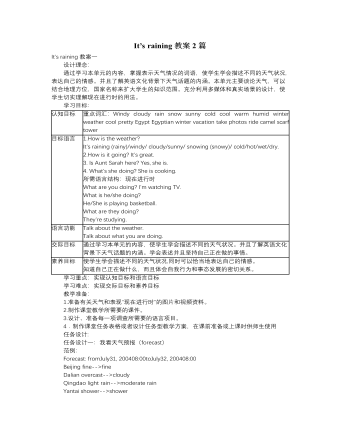
人教版新目标初中英语七年级下册It’s raining教案2篇
1 Each group choose one place to describe and what you are doing in it Choose one place, and describe what they are doing 2 Move around the room and give suggestions Talk about it and write it down 3 Ask one to show their works and act it Choose one of each group to make a report 4 Evaluate the best group and the best reporter Choose the best one Homework Ask your friends their ideal place and write about it教学反思:新课程标准中强调学生在课堂中的主体地位,在综合课中他们的主体地位就更加突出。在各个活动中给不同程度的学生不同层次的任务,让各层面的学生都有表现发挥的机会,从而产生对英语的兴趣。使用照片图片多媒体来辅助教学,效果更好。同时让了解其他国家风景,风俗的同学介绍ideal place,增加学生的背景知知识,实现跨学科交流的目的。教案点评:采用任务型教学模式,在各个活动中给不同程度的学生不同层次的任务,让各层面的学生都有表现发挥的机会,从而产生对英语的兴趣。使用照片图片多媒体来辅助教学,效果更好。让了解其他国家风景,风俗的同学介绍ideal place,增加学生的背景知识,实现跨学科交流的目的。
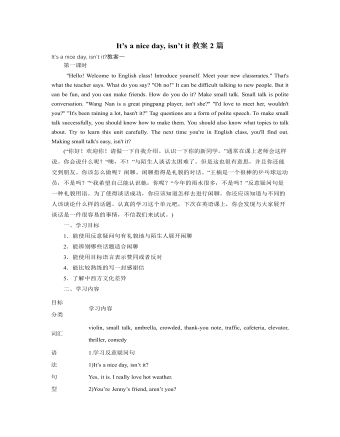
人教版新目标初中英语八年级下册It’s a nice day, isn’t it教案2篇
"Hello! Welcome to English class! Introduce yourself. Meet your new classmates." That's what the teacher says. What do you say? "Oh no!" It can be difficult talking to new people. But it can be fun, and you can make friends. How do you do it? Make small talk. Small talk is polite conversation. "Wang Nan is a great pingpang player, isn't she?" "I'd love to meet her, wouldn't you?" "It's been raining a lot, hasn't it?" Tag questions are a form of polite speech. To make small talk successfully, you should know how to make them. You should also know what topics to talk about. Try to learn this unit carefully. The next time you're in English class, you'll find out. Making small talk's easy, isn't it? (“你好!欢迎你!请做一下自我介绍。认识一下你的新同学。”通常在课上老师会这样说。你会说什么呢?“噢,不!”与陌生人谈话太困难了。但是这也很有意思,并且你还能交到朋友。你该怎么做呢?闲聊。闲聊指得是礼貌的对话。“王楠是一个很棒的乒乓球运动员,不是吗?”“我希望自己能认识她,你呢?“今年的雨水很多,不是吗?”反意疑问句是一种礼貌用语。为了使得谈话成功,你应该知道怎样去进行闲聊。你还应该知道与不同的人该谈论什么样的话题。认真的学习这个单元吧,下次在英语课上,你会发现与大家展开谈话是一件很容易的事情,不信我们来试试。)
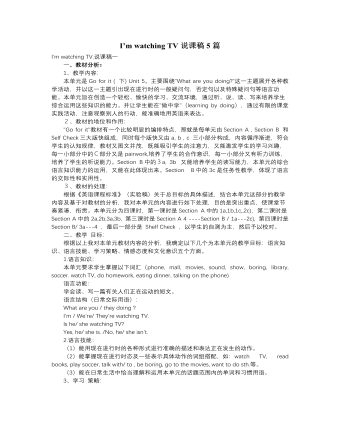
人教版新目标初中英语七年级下册I’m watching TV说课稿5篇
“Go for it”教材有一个比较明显的编排特点,那就是每单元由Section A , Section B 和 Self Check三大版快组成,同时每个版快又由a, b , c 三小部分构成,内容循序渐进,符合学生的认知规律,教材又图文并茂,既能吸引学生的注意力,又能激发学生的学习兴趣,每一小部分中的C部分又是pairwork,培养了学生的合作意识,每一小部分又有听力训练,培养了学生的听说能力。Section B中的3a, 3b 又能培养学生的读写能力,本单元的综合语言知识能力的运用,又能在此体现出来。本单元是新目标英语七年级下 Unit 5。主要围绕“What are you doing?”这一主题展开各种教学活动,并以这一主题引出现在进行时的一般疑问句,否定句以及特殊疑问句等语言功能。本单元旨在创造一个轻松、愉快的学习、交流环境,通过听、说、读、写来培养学生综合运用这些知识的能力。并让学生能在“做中学”(learning by doing),通过有限的课堂实践活动,注意观察别人的行动,能准确地用英语来表达。
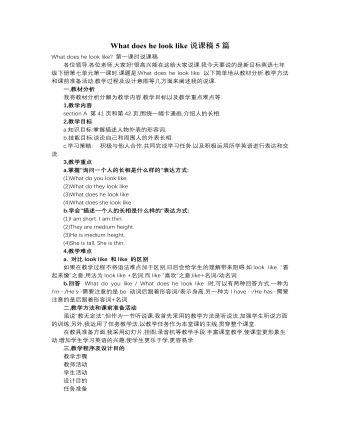
人教版新目标初中英语七年级下册What does he look like说课稿5篇
(四)、小结及布置作业(5’)对于本课的复习要点,我以课堂小结的形式展示给学生。(出示大屏幕)这样学生通过小结,对本课内容能够再次重申,体现出了本课的重点,使知识更加系统化、规范化。为了巩固本课内容,我给学生布置如下家庭作业。(出示大屏幕)课后描述一下你的父母,并写在作业本上四、板书设计(出示电脑屏幕)板书除了课题之外,我将本课的重点词汇always书于板书,并附例句,利于学生掌握该词的用法。并将本课的难点内容be+adj ,have+n.的用法书于板书,并附例句,利于学生突破难点。该板书简洁、清晰、明了,突出了本课的重难点。本课我以素质教育为目的,结合教材的重难点及英语学科的特点,采用任务型教学,从听、说、读、写、练等方面使学生得到了锻炼,在轻松、愉快的氛围中温故而知新,达到了培养学生用英语交际的目的。
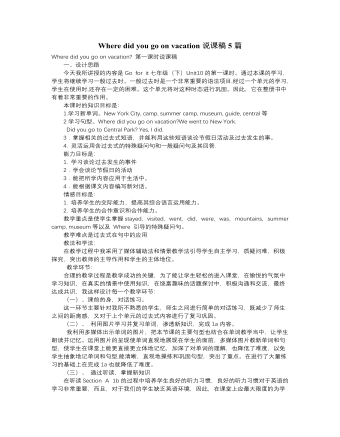
人教版新目标初中英语七年级下册Where did you go on vacation说课稿5篇
三、说教法只有当教师既在思想上把学生当成真正的学习主体,又在课堂教学过程中始终把学生当做学习的主人,教学目标才能实现,教学效率和效益才可能提高。因此课堂上加强对学生学习策略的指导是非常重要的,要使课堂教学过程成为师生共同参与,相互作用与反馈,创造性地实现教学目标的过程。另外,结合本节课内容特点,我还确立了“任务型”教学模式,并配合情景教学来实现教学目标。四、说学法课程标准倡导:教学要着眼于学生的全面成长,促进学生认知、情感、态度与技能等方面的和谐发展,着眼于学生潜能的唤醒,开掘与提升,促进学生的自主发展;关注学生的生活世界和学生的独特需要的有机结合,促进学生有个性,有特色的发展,关注学生的终身学习的愿望和能力的形成,促进学生特性发展。因此我确定本节课学习策略是:1、积极调动学生参与的积极性,指导学生感知,体验参与和合作。2、通过阅读,获取信息,并能回答相关问题。3、善于发现总结或把知识归类,按一定语言规律加以运用。
It’s raining说课稿5篇
It’s raining! 第一课时说课稿
说教学背景
这一单元的中心话题是Describethe weather。语法现象是Present progressive tense。继Unit5 I’m watching TV第二次出现了现在进行时态,是上一单元的延续。

比较上一单元,本单元增设了一个日常生活中重要的情景Talking about the weather 。学生不但要具备并熟练得掌握现在进行时态的意识和技巧,并且要会运用这一时态描述在各种没的天气背景下人的活动。可以说任务重,难度大。在教学前我们是否适当地布置学生课前任务,从而更好得活用教材?
说教材内容
本单元语言训练的重点是(1)谈论天气;(2)描述正在发生的动作。重点语言结构是(1)How引导的特殊疑问句;(2)Yes/No问句及答语;(3)现在进行时的用法。Section A主要是听读说和基础语言运用,为目标句型提供分步示例和指导性练习;Section B知识扩展、新旧知识的运用,循序渐进的写作练习;运用所学的语言完成各种任务使学生能够对已经学过的目标句型运用自如:Self -Check自我评价,词汇知识的评价,语言应用能力的评价。
第一课时说课稿
一、教学目标
1、知识目标
1)单词:rain windy cloudy sunny snow Moscow Boston how’s bad terriblepretty weather cool cold humid warm hot
2)句型:How’s it going?
How’s theweather?
2、能力目标:通过此课学习,使学生能够学会打招呼和描述天气。
3、情感和文化目标:了解异地天气和异国招呼用语。
二、教学重点:掌握招呼用语和描述天气用语。
三、教学难点:掌握并运用How’s theweather?----It’s…
四、教学设计
Step 1 Greeting
1)通过问:How are you? What day is it today?What is the date today? How’s it going?引出本课时的问候语。
2)看图片教会Not bad, Great! Terrible! Prettygood! 等问候回答语。
3)完成P27,3a
Step 2 Presentation(把Section A la, Section B la融合在一起教学天气用语)
可以这样导入:让学生问老师:How’sit going, Miss Chen?引出weather和How’sthe weather today?然后在利用各种图片导出新单词。当然,新单词的引入尽量让学生自己讲出来,因为已经提前布置任务,进行课前预习和查阅。
Step 3 Practice
教完了新单词,我设计了以下三个步骤来加以巩固
1)看图片进行问与答
How’s theweather?
It’s…
2)天气图片和天气单词进行连线
Match the wordswith the pictures
(some words andsome pictures)
3)A guessing game
T: Tomorrow Iwant to go shopping, which kind of weather is the best?
Ss: I think it’s…(在猜猜的游戏中,不仅及时巩固和运用了各种天气的表达,同时复习了前一单元的知识点,也为下一个步骤做了铺垫)
Step 4 Presentation
1)T: You are very clever, tomorrow isfine, I want to take you to thebeautiful cities. Where shall we go?
Ss:
T: Look, where isit?
Ss: It’s…
T: How is theweather in…?
Ss: I thinkit’s…in…
T: You are right,it’s…(Show the weather if it is right)
2)Practice(去掉天气,让学生凭记忆问与答)
S1: How’s theweather in…?
S2: It’s…(somepairs)
3)完成P31,1b
Step5 Task: Asking the weather
让学生通过这个活动,把今天所学的知识进行巩固和拓展。
步骤如下:
1、其他学生组成三人一小组计划去旅游,分工如下:
2、教师分给他们不同的地图。
3、分工做事,讨论并派一人进行汇报天气和决定去旅游的地方。
4、最后,教师对学生的表现进行评价或由学生互评。
Step6 Listening text(了解异国天气,增加文化意识的渗透)
Listening text
A: Hi, Lucy!
B: Hi, Bob! How’s it going?
A: Not bad!
B: How’s the weather today!
A: Terrible. It’s foggy.
B: Oh, no, I think it will be sunny later on.
T: Where are theyfrom? How do you know?
Ss: ……
T: Yes, it’s inLondon. It’s foggy before, but not now. That was an old story. But it is stillvery humid.
Step7 Homework
巩固新教的单词及句型
It’s raining! 第一课时说课二
人教版新目标教材,话题广泛生动,任务真实,易于激发学生学习兴趣。课堂任务的设计从学生的兴趣和生活经验出发,话题贴近学生实际生活。提供符合真实生活的输入信息,激发学生参与真实语言活动的动机。从而,培养学生主动学习英语的兴趣。《英语课程标准》的总目标要求学生语言技能,语言知识,情感态度,学习策略和文化意识等多方面综合发展。所以本教学设计以新的教学思想,观念,方式和方法为指导,力求利用教材,开发教材,利用多种教学手段及教学资源服务于教学。学生自主学习,合作学习。注重过程,追求实效。
一,教材分析
1,教材内容分析:本单元的中心话题是“谈论天气”整个单元的内容围绕天气展开听,说,读,写的活动。通过本单元的学习,使学生掌握描述天气的基本词汇及对天气的提问,学会准确地表达自己对某种天气的喜好并说明原因,学会做天气预报,学会叙述在不同的天气背景下做什么。通过以上活动,使学生能够在实践中体会到学习英语的乐趣,更积极地运用目标语言,培养学生在实际生活中综合运用所学语言的能力。本节课是单元第一节课,本课的核心是让学生们掌握表示天气的形容词。问答天气的句式:How is the weather?It’s rainy. 与此同时复习并灵活运用现在进行时态。
2, 教学重点:
1)学习并掌握词汇:raining, rainy,sunny, cloudy, foggy, snowing, snowy, windy, hot, cold, warm, cool, humid, dry,etc.
2) 熟练掌握现在进行时的用法。
3, 教学难点:学会描述人们在不同天气里所做的运动及运用自己的方式做天气预报。
4,教学目标:
1)知识目标:学习、掌握描绘天气状态的形容词及现在分词,如raining, sunny,cloudy, foggy, snowing, windy, hot, cold, warm, cool, humid, dry学习、掌握问答天气的句型,如 How is the weather? It’sraining.
2)能力目标:学会通过询问天气展开话题。学会叙述在不同天气里所做的事情。
3)情感目标:通过实践让学生体验在生活中运用英语的乐趣,并通过小组活动,培养学生互相合作,互相学习的团队精神。培养教育学生善于观察天气,善于描绘周围事物的能力。
4)学习策略目标:改变传统的死记更背,积极主动的投入到语言实践中去,在实践中提高语言的综合使用能力,加深对基础知识的掌握和记忆。
5)文化意识目标:在西方国家人们在很多情况下都会谈到天气,正如在我国人们以“吃了吗?”引起话题一样,通过本课的学习,让同学们更多的了解西方文化。更深入的理解不同的国家会有不同的风俗及文化。
二,说学情
七年级学生善于表现,愿意参与,各项活动设计如果能力够,水平足,他们都会热情的投入。具有一定的创造性思维。关于天气的话题,同学们会很感兴趣。但对东西方文化的差异需要进一步的了解和学习。
三,说教法
1,任务型语言教学法。人们使用语言的过程就是一个完成各种各样任务的过程。在本课的任务型语言教学中,我将依据课程的总体目标并结合教学内容,创造性的设计贴近学生实际的任务活动,吸引和组织他们积极参与,使学生通过观察,思考,讨论,交流和合作等方式,在一种自然,真实或模拟真实的情境中体会语言,掌握语言的应用。
2,情景交际法。课堂教学以情景交际教学法为主,昼给学生以足够的听说读的机会,联系实际,创设情景,引入讨论主题,在交际中学英语。情景的设计注意衔接的自然性,主题的设计强调知识的渐进性,并注意情感体验和推理思维的培养。
四,说学法
1,合作学习。合作学习是指学生通过分工合作共同达成学习目标的一种学习方式。本节课将在课堂活动中把学习分成两人一小级的学习小组,让他们围绕着课堂任务中合作,在活动中相互探讨,相互交流,相互合作,从而获得知识、技能和情感体验,发展他们的能力。
2,创设情景和有意义的任务活动,激发学生的学习热情,培养他们的主观能动性,变被动学习为主动学习。
3,课上重在口头,大胆开口。积极操练,课下和其他同学经常运用英语进行交流,在用中学,在学中用。将书本知识变为真正的属于自己的东西。
五.教学程序
1.歌曲导入:Rain, rain, go away.
2.学习并操练描绘天气的词汇。
1). 看图片,说单词。并了解一些词形的变化,如:rain- rainy。
2). 通过描述四季中某一天的天气的特点。练习巩固新词。
3). 过找朋友游戏,进一步巩固一些常见的描述天气的词语。
3. 学习并练习句型:How is the weather?It’s rainy.
1)方式是熟读,然后看图片编对话。并加入现在进行时的复习。
2) 打电话,复习现在进行时,巩固问答天气。
3)通过预报天气活动,联系生活实际,贴近生活,增强课上的趣味性。进一步练习巩固所学内容。本活动有文字提示,仿照电视上常见的天气预报。但也有所不同,重点巩固本节课,而不增加气温等天气因素
4,做书中P31 1a 1b 练习并巩固本节所学的词汇及句型。
5,Homework:
1) 把课上所做的天气预报形成文字。
2)根据书中31页图片,编写两组对话。必须包含问答天气状况,在不同的天气情况下正在做什么。
It’sraining!第一课时说课稿(英文版)
Introducemyself.
一. Teaching materialanalysis
1.Theachingitems: This lesson is the first lesson in Unit-6. It’s also a main point inthis lesson, which provides an example for the target sentence construction. It’sincreases the students synthetic ability of hearing, speaking, reading, writingby reviewing the present continuous tense.
2. Aims to theteaching:
A. Aim to theknowledge:
To learn thetarget words raining, windy, cloudy, sunny, snowing in this lesson. The targetsentence construction in this lesson is: How is the weather?
B. Aim to theabilities :
To improve thestudents communication ability.
C. Aims to theemotion:
To train thestudents to love our nation, and develop their good charactor.
3. Difficultand important points:
To get the local weather information by usingtheir knowledge which they have learnt.
二. Teaching method--- theinvestigative method
As we allknow: the main instructional aims of learning English in middle school is tocultivate students’ basic abilities of listening 、speaking、reading and writing and their good sense of the English language. Soin this lesson I’llmainly use “Task-based” teaching method. That is to say, Iwill let the Ss learn in real situations, finish a task by making a survey tohelp the Ss to get a better understanding of the key structure of theconversation. And in this lesson communication metho D、scene method andCAIwill be needed.
三.Study method---theinvestigative method
I request the students to study Englishindependenly cooperatively and investigatively. Each unit in Go for it containspair work, group work and games. The students who sit at the same table andgroups can make a discussion and learn each other. It makes each student berelaxed. They needn’t worry about making mistakes. It can arouse students tothink and to say what they want to say. Study becomes more relaxed and pleasedin this kind of environment.
四.The time table ofteaching steps
1.Review. Itwill take me 7 minutes.
2.Presentation.This is the most important part in this lesson. It will take me 32 minutes.
3.The study ofdiffuse thought. It will take me 4 minutes.
4.Brieflysummary and homework. It will take me 2 minutes
五.Teaching steps
I’ll finish this lesson in 5 steps.
Step1---Review
Purpose: Toform a better surrounding for the students by speaking anddoing some totalphysical response and at the same time it provides situations to review learntknowledge for the next step.
1.Let astudent greet and make a duty report.
2.Free talkbetween T and Ss about last unit.
3.Review thepresent continuous tense by software.
I will make aconversion with the students . I ask ,students answer.The question is:“ What ishe doing?” Students answer:“ He is singing.” The second picture,“ What are theydoing?” “They are playing chess.”And then I will let the students ask andanswer in pairs using the target sentences “What is he doing?” “What is shedoing?”“What are they doing?”. Make sure the students ask and answer correctly.They can use the words:dance、go to school、swim、play computer games、paint、 watch TV and run.
Step2---Presrntion
The purpose is to present the key words one byone is much easier for the students to learn and grasp the meaning. CAI providea real situation for students to understand the conversation better.
I’ll mainly talk about this step.
1.I’ll use apicture to ask a question: “Isn’t raining?” Ss answer:”Yes,it is.” Then I’lltell them if you want to know the weather, you can ask:“How is the weather?”The answer is:“It’s raining.” “raining ”is a target word and “How is theweather?” is a target sentence. Help the Ss understand the meaning by bodylanguage. Then lead the Ss to read the sentences. Make sure they can say themout correctly.I will use the other pictures to teach the target words “windy 、cloudy、sunny and snowing”.
2.I will usethe other pictures to teach the other target words“windy, sunny cloudy andsnowiny.”
These are the sentencesthey must master. “How is the weather?” “It’s cloudy”. “It’s windy.” “It’ssunndy.” “It’s snowing.” and“It’s raining.”
3. After theyfinish learning the target words. I will ask them to open the books and turn toP53. I will teach 1a
This activityintroduces the key words.
After theyfinish I will give them the right answers.
4.We will dolistening exercise 1b
This activitygives student practice in understanding the target language in spoken English.
The studentscan listen twice and finish them.
5.1c pairwork.
This activityprovides guided oral practice using the target language.
Ask thestudents to make a conversation in pairs according to the model.
6.After theyfinish, we will go on listening exercises. Look at Page 54-2a.
At first Iwill point to the four pictures. Ask students to tell what each person is doingin each picture. For example “The boy is talking on the phone”. “The men isplaying basket.”and so on. Then I will play the tape twice and the Ss numberthe pictures. I will give them the right answers.
7.Go onlearning 2b. It’s listening exercises,too.
I will ask astudent to read the list of names and another student read the list ofactivities for the class.Then play the tape twice. The students tisten andmatch the names and the adivties. After they finish , I will give them thecorrect answers.
8.2c-Pairwork.
I will ask SSto make conversations in pairs, I’ll ask some pairs to present theirconversations to the elass.
9.After learningthe text. I will let Ss do some more oral exercises.
This is aweather report. I’ll let the students make a conversation in pairs with theweather information using the target words and sentences. 天气报告
北京 | 上海 | 广州 | 西安 | 昆明 |
晴 | 雨 | 多云 | 雪 | 有风 |
eg,How is the weather inBeijing/Shanghai……?
It is sunny/rainy…….
Step3.The study of diffuse thought.
Purpose:In order to raise studentsEnglish level, I will teach them word-building --how to change nouns intoadjectives. It can help them improve the abilities of remembering words easily.The words are sun–sunny, snow–snowy, wind-windy, rain-rainy, cloud-cloudy.
Step4.Summary and homework.
Purpose:It’s important for students tospeak English as much as possible in class or after class.It’s nesessery forthem to do some extensive exercise after class to consolidate the knowledgethey learned.
In this lesson, We have learnt somewords and sentences about the weather .Ss can use these to ask and answer aboutlocal weather imformation. Homework for this lesson is:
1) Finish off the workbook.
2) Listen to the local weather reportand get ready for the coversation for tomaorrow.
3) Remember the target words andsentences by heart.
Design of blackboard
It’s raining!
---It’s raining/rainy.
How’s the weather? ---It’s sunny.
---It’s cloudy.
---It’s windy.
--- It’s snowing/snowy.
What’s he/she doing?---He’s/she’s……
What’re they doing?---They’re ……
It’s raining!说课稿
我说课的内容是新目标英语七年级下册Unit6 It’s raining.主要从教材分析、教学目标、学生情况、教学方法及教学程序方面做具体的阐述。
l说教材
本单元的话题是Weather, 天气与我们生活息息相关,本课知识大多数同学都比较感兴趣和喜欢学习,相信同学们在学习中充满期待。
l说教学目标
根据《英语课程标准》的教学理念将本课时的目标确定如下:
认知目标:能够听、说、读、写、用本课时的主要单词:
raining、snowing、windy、cloudy、sunny…
主要句型:
A:How’s it going?
B: great/ prettygood/not bad/terrible
A: what are youdoing?
B: I am reading abook/ watching TV.
A: How is theweather in…
B: It’ssunny/raining/snowing/cloudy…
A: What do youusually do when it is sunny/….
B: I usually read abook.
能力目标:能够听懂录音中的对话,并能分角色进行扮演,能够很好的完成group work
情感目标:通过活动、游戏使学生对英语学习产生兴趣;让学生敢于、乐于开口,积极参与交流。并让学生在学习的过程中,培养学生的合作意识和竞争意识。
l说学情
刚刚步入初中的学生,英语基础知识和听说能力普遍较差,大部分学生虽然在小学接触过英语,但应用能力十分薄弱,而且不正规的书写习惯已经养成,很难纠正。因此,面对学生掌握英语的程度不一,将采用分层教学与整体教学相结合的方式完成教学任务,努力提高他们的英语水平。
另外,学生在情感态度,学习策略和文化意识方面还存在诸多需要进一步解决的问题。例如:个别学生不明确学习英语的目的;有些同学对学好英语缺乏自信,不敢用英语表达;缺乏小组合作意识;一些学生没养成良好的学习习惯,不能做好课前预习课后复习,学习没有计划性和策略性;不善于发现和总结语言规律,不注意知识的巩固和积累。
针对这种情况,在入门教学阶段,努力做好中小学的衔接,培养良好的学习习惯,并为提高学生学习兴趣想一些办法。如通过学生们喜爱的游戏、竞赛等方式反复练习一些基本单词、基本句型。
l说教法
1、重示范。在教单词时,要求教师自己示范到位,发音清晰,讲解发音要点。同时培养学生认真听,专心看,积极模仿的好习惯。听清后再跟说。确定学生大都听清,模仿正确后,再出示单词卡片,以免分散学生的注意力。对直观的单词配以图片、体态语帮助学生理解。顺利完成音——形——义的逐步过度。
2、重情景。单词是构成语言的三大要素之一。人类思维活动是借助词汇进行的。人类思想的交流也是通过由词构成的句子来实现的,因此单词具有语言的意义,应在特定的语境中引出,这样既便于学生理解,印象也深刻。
3、重迁移。在教学中注重 “以旧带新”或叫“相互迁移”。
4、重趣味。英国著名语言家埃克斯利说:“教英语的最好的方法就是能引起学生学习英语兴趣的那种方法。”我们在单词教学中不能让学生死记硬背,而应尝试运用多种形式巧记。如编顺口溜,英汉意义对照等。
5、重运用。学习单词的目的是为了运用词汇,并能正确运用到笔头表达之中。在英语教学中创设一定的语言情景,使学生宛如置于一种真实的语言环境中,就能使学生自然而然使用所学习词汇来表达他们的思想感情,从而达到学以至用的目的。
l说教学程序
遵循人类认识过程的普遍规律和学生认识的主要特点,我把教学过程分为以下几个环节:
第一、导入
向学生问好,复习前单元学习的现在进行时。What are theydoing?What’s he/she doing?
自由谈话:
Today, why I change myclothes? Because it’s warm and sunny 聊一下日常生活,为后文做铺垫。
第二、呈现
1、利用课堂卡片,呈现不同的天气符号,引出weather这一话题。
2、让同学们把课文中的图片与天气搭配起来,检查和核对。
3、引出五大城市: Beijing,Shanghai, Moscow, Boston and Toronto。
4、从而根据图片提问:What’sthe weather like in these cities?
5、创设天气播报员和同事对话的情景,让学生编对话。
第三、操练
说一说:利用教学卡,反复练习句型:What’s the weather like in…/How is the weather in...
演一演:让学生扮演两个不同角色操练这一句型
第四、拓展延伸
让同学扮演电话通话角色,操练以下句型
A :How is it going?
B: …
A: What are you doing?
B: …
A: How is the weatherthere?
B: …
第四、课后作业
了解三个地区的天气,按照课堂句型,写一段对话。
It’s raining!说课稿
教学背景点击
这一单元的中心话题是Describe the weather。语法现象是Present progressive tense。继Unit5 I’m watching TV第二次出现了现在进行时态,是上一单元的延续。
比较上一单元,本单元增设了一个日常生活中重要的情景Talking about theweather 。学生不但要具备并熟练得掌握现在进行时态的意识和技巧,并且要会运用这一时态描述在各种没的天气背景下人的活动。可以说任务重,难度大。在教学前我们是否适当地布置学生课前任务,从而更好得活用教材?
教材内容点击
本单元语言训练的重点是(1)谈论天气;(2)描述正在发生的动作。重点语言结构是(1)How引导的特殊疑问句;(2)Yes/No问句及答语;(3)现在进行时的用法。Section A主要是听读说和基础语言运用,为目标句型提供分步示例和指导性练习;Section B知识扩展、新旧知识的运用,循序渐进的写作练习;运用所学的语言完成各种任务使学生能够对已经学过的目标句型运用自如:Self -Check自我评价,词汇知识的评价,语言应用能力的评价。
单元说课点击
一、 学习内容
本单元主要学习怎样打招呼和描述、谈论天气;学会描述在不同的天气背景下人的活动,时态主要也是现在进行时,是上一单元的继续。
二、学习目标
1、语言知识
1)语音了解语音在语言学习中的意义
2)词汇略
3)语法(1)现在进行时(2)有关天气的特殊问句及答语
4)日常交际用语
How’s the weather? It’s raining.
What’s the weather like in Shanghai?It’s sunny.
What are you/they doing? We/They are watching TV.
What is he/she doing? He/she is cooking.
How’s it going? Great!
2、语言技能
1)能用英语打招呼和描述并谈论不同的天气。
2)能用现在进行时互相交流。
3)能用现在进行时叙述在不同地方的和不同的天气背景下人们能做的事。
3、情感态度
1)通过课文教学引导学生关注天气情况,爱护环境,保护大气等自然资源的良好意识。
2)通过学习打招呼、谈论天气和所做的事时所用的交际用语,学会与人友好相处。
3)通过学习和对比不同天气背景下人的活动,激发学生的内在情感,进行爱的教育。
4)能在小组活动中积极与他人合作,相到帮助,共同完成学习任务。
4、文化意识
了解不同地方和不同的天气背景下人们能做的事,互相交流不同国家的文化,对学生进行不同文化意识的渗透。同时让了解其他国家风景,风俗,增加学生的背景知识,增强学科间的交流。
5、学习策略
通过任务型的教学,让学生学会自主学习,归纳总结,培养主动学习的能力。尤其对所学内容能主动复习并加以整理和归纳的能力。
三、任务设计
1、结合课本内容学习有关天气的词汇和句型,收集课文中未出现的其他气候用语和招呼用语。
2、争当最佳“天气接线员”,询问和回答东南和西北方向天气。
3、为东南亚海啸灾区描绘一幅美好的家园。
4、假设你是中央电视台《Around The World show》一位主持人,请介绍一个你的城市或你感兴趣的城市的概况:气候,风俗,人情。
四、课时安排
第一课时:P31 P33,3a P34,1a,1b
第二课时:P32 PP33,3b P34,2a,2b,2c
第三课时:P35
第四课时:作文点评+Self check+当堂检测
分课时说课点击
第一课时
一、教学目标
1、知识目标
1)单词:rain windy cloudy sunny snow Moscow Boston how’s bad terrible pretty weather cool cold humid warm hot
2)句型:How’s it going?
How’s the weather?
2、能力目标:通过此课学习,使学生能够学会打招呼和描述天气
3、情感和文化目标:了解异地天气和异国招呼用语
二、教学重点:掌握招呼用语和描述天气用语
三、教学难点:掌握并运用How’sthe weather?----It’s…
四、教学设计
Step 1 Greeting
1)通过问:How are you? What day is it today? What is the date today? How’s it going?引出本课时的问候语。
2)看图片教会Not bad, Great! Terrible! Pretty good! 等问候回答语。
3)完成P33,3a
Step 2 Presentation(把Section A la, Section B la融合在一起教学天气用语)
可以这样导入:让学生问老师:How’sit going, Miss Zheng?引出weather和How’s the weather today?然后在利用各种图片导出新单词。当然,新单词的引入尽量让学生自己讲出来,因为已经提前布置任务,进行课前预习和查阅。
Step 3 Practice
教完了新单词,我设计了以下三个步骤来加以巩固
1)看图片进行问与答
How’s the weather?
It’s…
2)天气图片和天气单词进行连线
Match the words with the pictures
(some words and some pictures)
3)A guessing game
T: Tomorrow I want to go shopping, which kind ofweather is the best?
Ss: I think it’s…(在猜猜的游戏中,不仅及时巩固和运用了各种天气的表达,同时复习了前一单元的知识点,也为下一个步骤做了铺垫)
Step 4 Presentation
1)T: You are very clever, tomorrow is fine, I want to take you to thebeautiful cities. Where shall we go?
Ss:
T: Look, where is it?
Ss: It’s…
T: How is the weather in…?
Ss: I think it’s…in…
T: You are right, it’s…(Show the weather if itis right)
2)Practice(去掉天气,让学生凭记忆问与答)
S1: How’s the weather in…?
S2: It’s…(some pairs)
3)完成P31,1b
Step5 Task: Asking the weather
让学生通过这个活动,把今天所学的知识进行巩固和拓展。
步骤如下:
1、四个学生上来当电话接线员
2、其他学生组成四人一小组计划去旅游,分工如下:obvaso, recorder, reporter, helper
3、教师分给他们不同的地图
4、分工做事,讨论并派一人进行汇报天气和决定去旅游的地方。
5、最后,教师对学生的表现进行评价或由学生互评。
Step6 Listening text(了解异国天气,增加文化意识的渗透)
Listening text
A: Hi, Lucy!
B: Hi, Bob! How’s it going?
A: Not bad!
B: How’s the weather today!
A: Terrible. It’s foggy.
B: Oh, no, I think it will be sunny later on.
T: Where are they from? How do you know?
Ss: London foggy.
T: Yes, it’s in London. It’s foggy before, butnot now. That was an old story. But it is still very humid.
Step7 Homework
巩固新教的单词及句型
第二课时
一、教学目标
1、知识目标
1)单词:cook study
2)句型:What are you/they doing? We/They are…
What ishe/she doing? He/she is...
2、能力目标:运用现在进行时问与答以及简单描述人的生活。
3、情感和文化目标:通过了解和比较不同地区人们的生活情景,激发学生内在情感,进行爱的教育。
二、教学重点:运用现在进行时
三、教学难点:综合运用现在进行时来描述天气和情景。
四、教学设计
Step1 Revision
1)复习前一课的一些内容
a)T: How is it going?
How’s everything going?
How’s the weather?
b) Practise in pairs P33, 3b
2)复习现在进行时,可以这样导入
T: It’s a fine day, isn’t? What are you doingnow?
Ss:…
T: Now, look what is he doing? Guess!(Show some pictures)这样,让学生带着一种探究的心理,去猜图片中的内容,这样,可以使学生的语言和思维得到同步发展。
Step2 完成课文P32,2a,2b,2c
1)Listen and number the pictures as you hear
2)Listen and match the names with the activities
3)Pairwork(以打电话对话的形式)
4)Describe the pictures
Step3 Who has a best memory
设这一步骤的目的是使学生在具体、真实的环境中综合运用How’s the weather?
What are they doing? How’s it going? 这几个句型。
Watch the cartoon of 《the Snowwhite and the drawfs》
1)T: Now boys and girls, are you tired? Would you like to watch acartoon? Let’s have a rest, OK?
Then get the Ss to watch the cartoon.
2)T: OK, do you like it? How do you like it? Would you like to watchit again?
Please answer these questions.
How’s the weather?
What are they doing?
How’s it going?
T: Let’s say: who has a best memory?
Ss:
3)Fill in the blanks
A: Hello, Kitty!
B: Hi, Emma!
A:?
B: Pretty good!
A: How’s the weather today?
B:?
A: What are you doing now?
B:?
A: What can you see in the cartoon?
B ?
A: What are they doing in it?
B ?
设计这个活动的目的在于:通过以上几个环节,学生的听、说、读都得到一定发展的同时,再让学生做一个笔头练习,能进一步落实学生写的能力。
Step4 Make a survey and Draw a nice picture
让学生观看海啸灾区的情景,对比不同环境下人的活动,激起学生内在的情感,对他们进行爱的教育,鼓励他们为灾区献爱心,可以为灾区人们描绘一幅美好的家园。
Step5 Homework
关于海啸话题编写一对话。
第三课时
一、教学目标
1、知识目标
1)单词和词组:vacation lying group beach surprised heat
relaxedwinter scarf everyone man
2)句型:复习前几课句型
2、能力目标:学会用英语描述不同地方的天气和人的活动
3、情感目标:学习不同地方的天气和人的活动,来对学生进行不同文化意识的渗透。
二、教学重点:复习和运和本单元的单词及句型。
二、教学难点:用英语综合描述不同的季节及气候背景下人的活动。
四、教学设计
Step1 Revision
在这个复习环节中,我考虑在回顾单词、句型的同时,适当的融入一些新的、学生未知的内容,不至于复习好像是一项简单的“抄冷饭”式的工作。我设置几种情况,期待学生能在这个环节中自如地运用天气用语,一般现在时和现在进行时都得到复习巩固。
Situation1
T: How’s it going?
How’s the weather now?
Ss:
T: What are you wearing?
Ss: I’m wearing scarf sweater, gloves…
T: When is it now?
Ss: It’s winter.
T: What can you do in winter?
Ss: I can…
T: What’s he doing in winter?
Situation2
T: How’s the weather in the picture?
Ss: Warn.
T: When is it?
Ss: Spring.
T: What can you do in spring?
Ss:
T: Look, what is he doing in spring?
Ss:…
Situation3
T: How is the weather is it?
Ss: Hot/cool.
T: When is it?
Ss: Summer/autumn.
T: What can you do it summer/autumn?
Ss:
T: Look, what are they doing?
Ss:
Ss: He is lying on the beach./ They are playingbeach volleyball.
T: I’m surprised the can play in this heat. Whatdo you think of them?
Ss:…relaxed.
T: Where and when can they be so relaxed?
Ss: When he is free, he is on holiday, he is onvacation…
T: But how do you know the different weather?
Ss: From The radio/ the weather forecast/ the114/ CCTV.
Step2 完成P35, 3b
T: Right, a program called Around The World showin CCTV often show us some beautiful cities. It tells us something about theweather and what the people are doing. Look How’s the weather in France andwhat are they doing?
Ss: Fill in the blanks.
让学生了解法国的天气情况以及那里人们所做的事情。
Step3 完成P35, 3a
考虑到前面是让学生通过边看边读来完成填空,为了避免教学步骤的单调性和调节学生的积极性,这部分的阅读我是这样做的:
T: You know it is winter in France. What aboutin Australia?
1)Listen and answer: How’s the weather inAustralia? How do you know?
2)Read the passage quickly and underline the things that people aredoing. Circle the words that describe the weather.
T: When it is winter in France, it is summer inAustralia. So we know in different countries have different weather. 目的是对学生进行不同文化意识的渗透。
Step4 Describe the pictures
为了来拓展阅读教学,我让学生展示为灾区人们描绘的画,让其他学生欣赏的同时,要求学生四人一组合作讨论并派代表对画进行描述,时间限定为一分钟。
T: Boys and girls, do you remember the tsnami inSoutheast Asia? Did you draw a picture for the poor people after class? Pleasetake out and show us, ok? Is it nice? Look, what are they doing? How’s theweather? How’s it going? Please talk about the picture in groups of four forone minute. Then I will ask one of you to talk about it?
Ss:…
T: Who is the best?
Ss:
T: I think you are all very kind.. I believe youcan help others when they need help.
Step5 Homework
1)T: Your hometown is beautiful too. Can you write a passage about it?First you can make aninterview. What the people are doing in different weather?
Names How’sthe weather? What is he/she doing?
2)Write a passage about your hometown
3)Collect the words about weather and clothes
4)Collect the expressions about the greetings
第四课时
自我检查,自我评定
Step1Give a report(及时检查学生带回去的作业任务)
Step2 Whose composition is the best?(通过当堂写作文,使学生在单位时间内完成任务)
1)Write the composition in groups of four
2)Read and enjoy the compositions
3)Check the students’ compositions
(通过这个朗读、欣赏、点评文章这个环节,使学生在单位时间内得到一定的提高)
Step3 Selfcheck1(自我检测本单元单词的掌握情况)
Step4 Who has the most words and expressions
1)Write down what you don’t know on your pieceof the paper
(通过自我归纳、自我总结来巩固和增加单词、句型的储备量)
2)Finish selfcheck3
Step5Have a test(当堂检查学生对本单元知识的掌握)
1)Do the exercises
2)Selfcheck with ABC(用等级评定来代替分数的评定)
Step6 Arrange the homework in different level(根据学生对知识掌握程度的差异,布置不同的作业)
1)Recite and copy the words and expressions
2)Revise the text again
3)Look for some more beautiful passages to read
附表(一)语言实践•自我评价
〔实践活动1〕
以小组形式进行活动,注意收看电视的天气预报,并作好记录,向小组成员简单介绍自己记录的当天全国及世界各地的天气状况。
提示:How’s theweather today in Beijing?
It’s sunny/raining/windy/snowing …
Good morning, ladies and gentlemen!
Here is the weather forecast!
Today is Thursday.
Beijing is…Guangzhou is …
〔实践活动2〕
以小组形式进行活动,调查小组成员最喜欢的季节,要求介绍该季节的天气特征和习惯做的事情。
提示:1.spring,summer,autumn,winter
2.cold,hot,warm,cool,humid,foggy,windy…
3.What kind of weather do you like?
Whatseason do you like best?
What are you doing in
spring/in summer/in autumn/in winter?
Names Favoritsseason Reason Activity
附表(二)
姓名 学号 评估项目及内容 评估情况
单词和词组学习和运用情况 A B C D
语法掌握情况——现在进行时用法及构成 A B C D
学会介绍天气情况,描述天气 A B C D
学会谈论天气情况的好坏 A B C D
How引导的特殊疑问句的用法 A B C D
综合评估 A B C D
A. 很好 B.较好 C.一般 D.需努力
姓名 学号 评估项目及内容 评估情况
单词和词组学习和运用情况 A B C D
语法掌握情况——现在进行时用法及构成 A B C D
学会介绍天气情况,描述天气 A B C D
学会谈论天气情况的好坏 A B C D
How引导的特殊疑问句的用法 A B C D
综合评估 A B C D
A. 很好 B.较好 C.一般 D.需努力
附表(三)
学生自我检查评价表Unit6日期:
姓名 班级 学号
自 我 检 查 评 价
1、我会读、能听懂下列的单词和词组: 1、我还不会读、不能听懂下列的单词和词组:
2、我已掌握了下列的单词、词组(习惯用语) 2、我暂时未掌握下列的单词、词组(习惯用语)和句型
预览结束,下载后可阅读高清完整版文档
立即下载
转载请注明出处!本文地址:
https://www.lfppt.com/worddetails_43558244.html最新说课稿文档
-
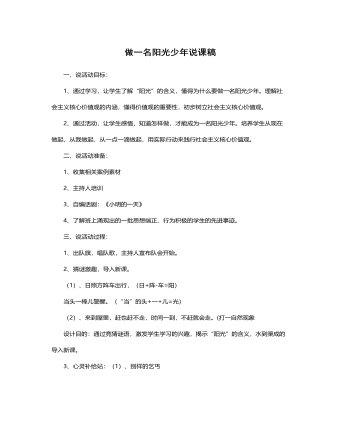
做一名阳光少年说课稿
1、紧密联系学生的生活实际,所选材料、所有活动均本着为主题服务的原则。2、形式多样化。通过心灵补给站、我来当编剧、心动不如行动等丰富多彩的活动,激发学生的热情,充分发挥他们的主体性。3、用生活中的真人真事激励他们,震撼他们的心灵,对学生进行教育,让他们得到感悟。五、说评价方式:要真正发挥主题队会的教育作用,千万不能把主题队会开成“检讨会”、“批评会”。兴趣是最好的老师,在课堂上,学生有了兴趣,才会有学习的动机,所以,在教学过程中,我努力把学生当作一个平等的朋友来对待,对于学生的回答进行评价时,本着“多表扬少批评,多鼓励少指责”的原则,尽量不用指令性、批评性的语言,最大限度的挖掘学生的优点,进行激烈性评价。
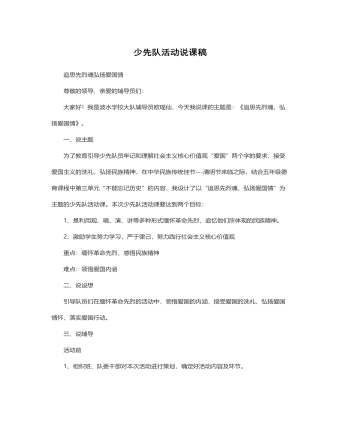
追思先烈魂,弘扬爱国情说课稿
环节四深入实践——弘扬爱国情爱国不是一句口号,要将爱国情怀落实到行动中去,队员们在各队队长的组织下,商讨出了落实方案。1、第一小队和第二小队组成了先烈故事演讲团,利用班会十分钟的时间,在三四年级宣讲先烈故事。2、第三小队和第四小队组成了创编小能手,编唱了爱国童谣、爱国拍手歌,告诉大家,爱国无处不在,爱国要从小事做起。3、第五小队和第六小队编写的爱国倡议书,提倡大家让爱国从口号落实到行动。4、全体队员共同宣誓:时刻准备着,为共产主义事业而奋斗,将活动推向了高潮。环节五大队辅导员总结“风雨沧桑,多遭铁蹄践踏,未有沉沦终奋起;荡涤污浊,重聚华夏精魂,披荆斩棘勇向前。”让我们牢记自己是中国人,怀一颗中国心,明确方向,努力奋斗,早日实现自己的梦想。
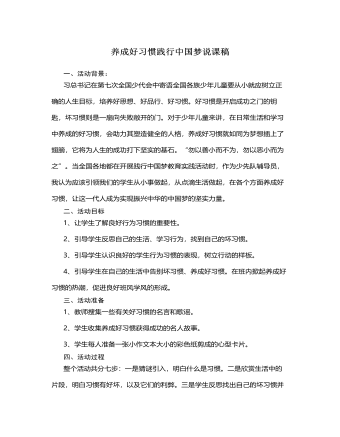
养成好习惯践行中国梦说课稿
第七步:全班学生一起倡读承诺书:(课件出示)我们都是小学生,培养习惯最要紧;上课应当专心听,积极开动小脑筋;作业认真仔细做,按时完成交得勤;有了错误要订正,知识才能学得清;人生要有好习惯,我们牢牢记心上。最后请学生把自己要养成的好习惯写在心意卡上,写好后粘贴在教室后面的园地里,互相督促,使得此次活动教育延续课后,直至影响一生.5、活动效果及反思此次活动开展后,学生们增强了对自身的认识,很多学生下决心改掉自身的坏习惯,并逐步采取了实际行动,从身边的小事做起,而且在学生中间还兴起了互相帮助、互相指正、争相进步的热潮。通过此次活动我也切实的体会到养成教育要开展就要落到实处,从实际出发,让学生亲自去感受,去体会,并且要持之以恒的做下去。同时作为老师更应该有一颗敏感热情的心,随时发现学生身上的闪光点与不足,多指正、多指点、多鼓励、多表扬,做到时时处处皆教育,这样才能赢得孩子,做好教育。
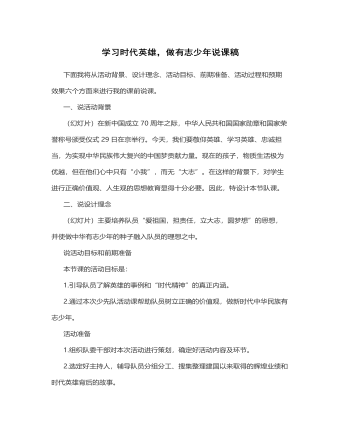
学习时代英雄,做有志少年说课稿
一、说活动背景(幻灯片)在新中国成立70周年之际,中华人民共和国国家勋章和国家荣誉称号颁受仪式29日在京举行。今天,我们要敬仰英雄、学习英雄、忠诚担当,为实现中华民族伟大复兴的中国梦贡献力量。现在的孩子,物质生活极为优越,但在他们心中只有“小我”,而无“大志”。在这样的背景下,对学生进行正确价值观、人生观的思想教育显得十分必要。因此,特设计本节队课。二、说设计理念(幻灯片)主要培养队员“爱祖国,担责任,立大志,圆梦想”的思想,并使做中华有志少年的种子融入队员的理想之中。说活动目标和前期准备本节课的活动目标是:1.引导队员了解英雄的事例和“时代精神”的真正内涵。2.通过本次少先队活动课帮助队员树立正确的价值观,做新时代中华民族有志少年。
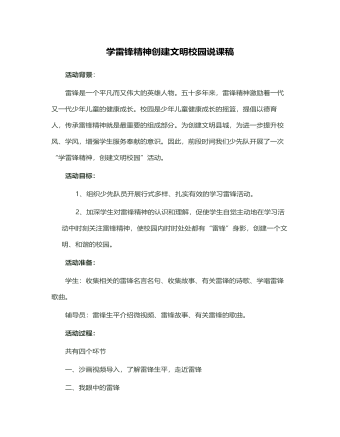
学雷锋精神,创建文明校园说课稿
雷锋精神是什么?这一环节是让学生用简单的词语或句子概括。通过这一活动,让学生概括出雷锋精神的内涵:像无私奉献、乐于助人、为人民服务、勤俭节约、尊老爱幼、勤奋好学、干一行爱一行、言行一致等等都是雷锋精神的体现。我们少年儿童是中国的未来和希望,雷锋精神的发扬和光大,创建文明校园的任务就落在他们的肩上,所以在这里我还设计了为发扬雷锋精神,创建文明校园“我该怎么做”这样的问题,目的就是让他们一起行动起来,学雷锋做好事,并制作了“荣誉”旗,奖励身边的好人好事。活动延伸:这里我设计了一个角色游戏活动——我要义卖献爱心,这个游戏学生们表现得非常积极,他们收集了自己不要的小文具或小玩具,将他们拿到集市上去卖,卖东西获得的钱,捐给王奶奶的孙女,因为王奶奶的孙女生病了,无钱治病。我觉得这个游戏使学生们懂得,一个人只要有爱心,只要愿意去帮助别人,无论什么方式都行,而且在游戏活动中孩子们体会到了帮助别人是一件多么多么快乐的事呀。
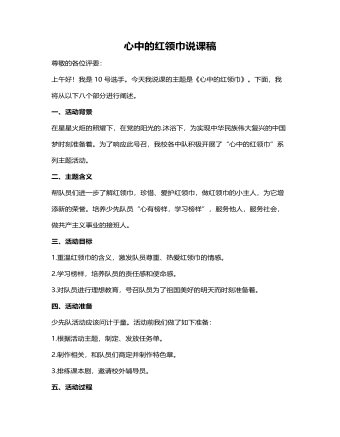
心中的红领巾说课稿
1.学习“最美红领巾”。图文结合,学习“美德少年”刘华婷、刘颖等人的先进事迹。2.记录“平凡红领巾”。展示队员们活动前精心准备的“随手拍”,发现普通队员在日常生活中的闪光点。3.填写“我为红领巾添光彩”心愿卡,对学生进行理想教育。4.齐唱《红领巾之歌》,点燃信念火种。5.辅导员对此次活动进行总结,并颁发特色章。(出示三个特色章图标)六、活动延伸红领巾精神需要代代相传,珍爱红领巾的意识需要时时提醒,本次活动后,我们会开展“小小新四军”、“鲜艳的红领巾”等后续活动,帮助队员们将红领巾精神永远铭记在心。七、引导要点四年级队员具备一定的活动能力和经验,通过课本剧的亲身体验、心愿卡的真情表达等多种方式的运用,引导队员热爱红领巾,以红领巾精神指引自己健康成长。八、活动评价本次活动,队员们受到了良好的教育。但是四年级队员自我约束能力不够强,缺乏持久性,萌生的意识和激情往往只停留在活动时,不能在活动后内化为自觉行为,这些问题有待探究。
今日更新Word
-

精选高中生期末评语
1、该生学习态度端正 ,能够积极配合老师 ,善于调动课堂气氛。 能够积极完成老师布置的任务。学习劲头足,听课又专注 ,做事更认 真 ,你是同学们学习的榜样。但是,成绩只代表昨天,并不能说明你 明天就一定也很优秀。所以,每个人都应该把成绩当作自己腾飞的起 点。2、 你不爱说话 ,但勤奋好学,诚实可爱;你做事踏实、认真、为 人忠厚 ,是一个品行端正、有上进心、有良好的道德修养的好学生。在学习上,积极、主动,能按时完成老师布置的作业,经过努力 ,各 科成绩都有明显进步,你有较强的思维能力和学习领悟力,学习也有 计划性,但在老师看来,你的潜力还没有完全发挥出来,学习上还要有持久的恒心和顽强的毅力。

××县招商局2024年上半年工作总结
二是全力推进在谈项目落地。认真落实“首席服务官”责任制,切实做好上海中道易新材料有机硅复配硅油项目、海南中顾垃圾焚烧发电炉渣综合利用项目、天勤生物生物实验基地项目、恺德集团文旅康养产业项目、三一重能风力发电项目、中国供销集团冷链物流项目跟踪对接,协调解决项目落户过程中存在的困难和问题,力争早日实现成果转化。三是强化招商工作考核督办。持续加大全县招商引资工作统筹调度及业务指导,贯彻落实项目建设“6421”时限及“每月通报、季度排名、半年分析、年终奖励”相关要求,通过“比实绩、晒单子、亮数据、拼项目”,进一步营造“比学赶超”浓厚氛围,掀起招商引资和项目建设新热潮。四是持续优化园区企业服务。

“四零”承诺服务创建工作总结
(二)坚持问题导向,持续改进工作。要继续在提高工作效率和服务质量上下功夫,积极学习借鉴其他部门及xx关于“四零”承诺服务创建工作的先进经验,同时主动查找并着力解决困扰企业和群众办事创业的难点问题。要进一步探索创新,继续优化工作流程,精简审批程序,缩短办事路径,压缩办理时限,深化政务公开,努力为企业当好“保姆”,为群众提供便利,不断适应新时代人民群众对政务服务的新需求。(三)深化内外宣传,树立良好形象。要深入挖掘并及时总结作风整顿“四零”承诺服务创建工作中形成的典型经验做法,进一步强化内部宣传与工作交流,推动全市创建工作质效整体提升。要面向社会和公众庄严承诺并积极践诺,主动接受监督,同时要依托电台、电视台、报纸及微信、微博等各类媒体大力宣传xx队伍作风整顿“四零”承诺服务创建工作成果,不断扩大社会知情面和群众知晓率。
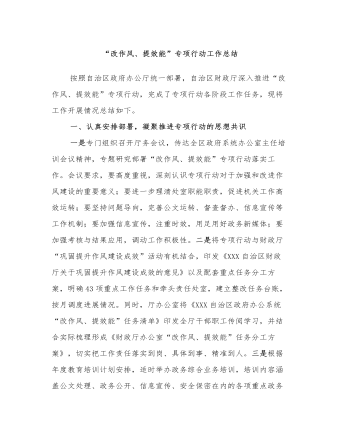
“改作风、提效能”专项行动工作总结
(五)服务群众提效能方面。一是政府采购服务提档升级。建成“全区一张网”,各类采购主体所有业务实现“一网通办,提升办事效率;全面实现远程开标和不见面开标,降低供应商成本;要求400万元以上工程采购项目预留采购份额提高至采购比例的40%以上,支持中小企业发展。2022年,我区政府采购荣获”中国政府采购奖“,并以全国第一的成绩获得数字政府采购耕耘奖、新闻宣传奖,以各省中第一的成绩获得年度创新奖。二是财政电子票据便民利民。全区财政电子票据开具量突破1亿张,涉及资金810.87亿元。特别是在医疗领域,全区241家二级以上公立医疗机构均已全部上线医疗收费电子票据,大大解决了群众看病排队等待时间长、缴费取票不方便的问题,让患者”省心、省时、省力“。
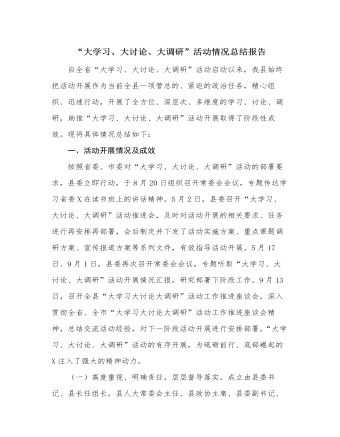
“大学习、大讨论、大调研”活动情况总结报告
一、活动开展情况及成效按照省委、市委对“大学习、大讨论、大调研”活动的部署要求,县委立即行动,于8月20日组织召开常委会会议,专题传达学习省委X在读书班上的讲话精神。5月2日,县委召开“大学习、大讨论、大调研”活动推进会,及时对活动开展的相关要求、任务进行再安排再部署,会后制定并下发了活动实施方案、重点课题调研方案、宣传报道方案等系列文件,有效指导活动开展。5月17日、9月1日,县委再次召开常委会会议,专题听取“大学习、大讨论、大调研”活动开展情况汇报,研究部署下阶段工作。9月13日,召开全县“大学习大讨论大调研”活动工作推进座谈会,深入贯彻全省、全市“大学习大讨论大调研”活动工作推进座谈会精神,总结交流活动经验,对下一阶段活动开展进行安排部署。“大学习、大讨论、大调研”活动的有序开展,为砥砺前行、底部崛起的X注入了强大的精神动力。
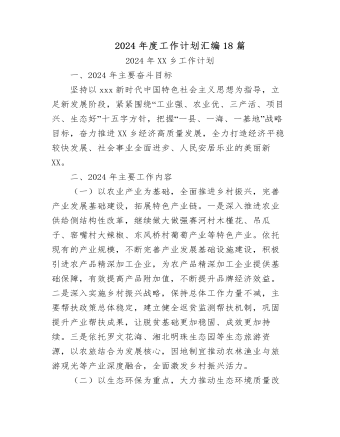
2024年度工作计划汇编(18篇)
1.市政基础设施项目5项,总建设里程2.13km,投资概算2.28亿元。其中,烔炀大道(涉铁)工程施工单位已进场,项目部基本建成,正在办理临时用地、用电及用水等相关工作;中铁佰和佰乐(巢湖)二期10KV外线工程已签订施工合同;黄麓镇健康路、纬四路新建工程均已完成清单初稿编制,亟需黄麓镇完成图审工作和健康路新建工程的前期证件办理;公安学院配套道路项目在黄麓镇完成围墙建设后即可进场施工。2.公益性建设项目6项,总建筑面积15.62万㎡,投资概算10.41亿元。其中,居巢区职业教育中心新建工程、巢湖市世纪新都小学扩建工程已完成施工、监理招标挂网,2月上旬完成全部招标工作;合肥职业技术学院大维修三期已完成招标工作,近期签订施工合同后组织进场施工;半汤疗养院净化和医用气体工程已完成招标工作;半汤疗养院智能化工程因投诉暂时中止;巢湖市中医院(中西医结合医院)新建工程正在按照既定计划推进,预计4月中下旬挂网招标。














 QQ登录
QQ登录 微信登录
微信登录